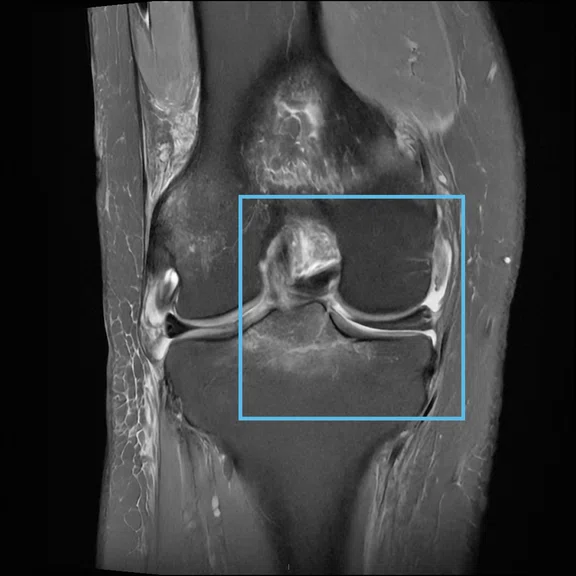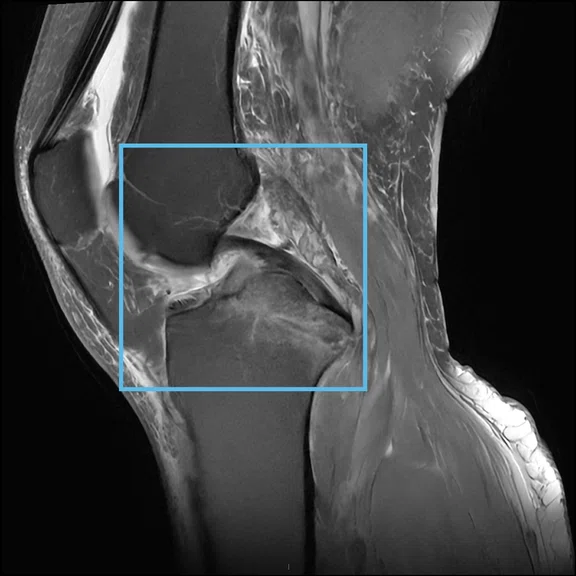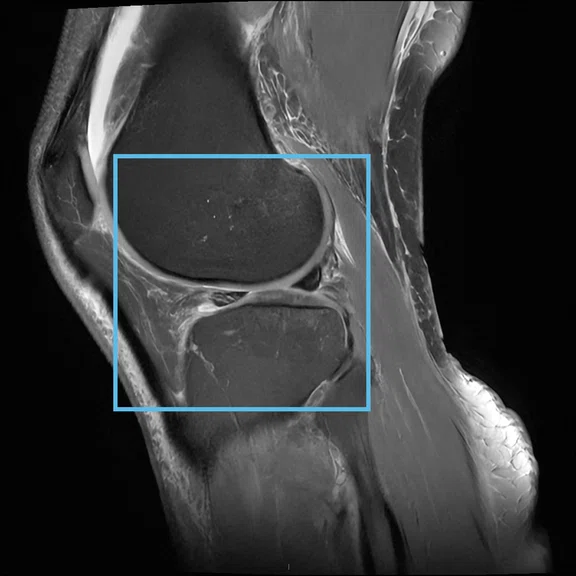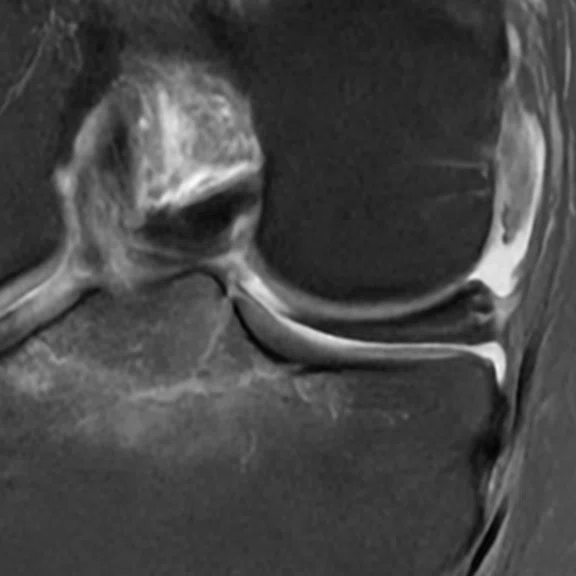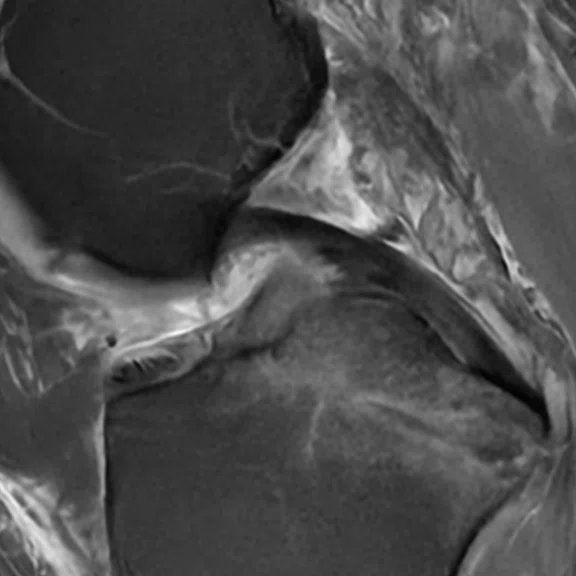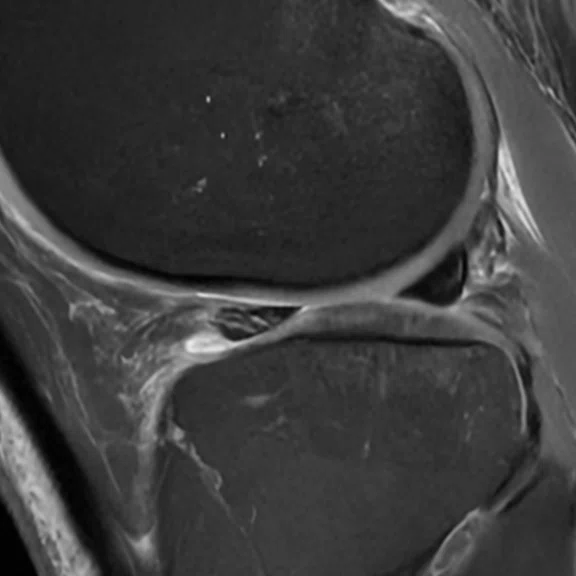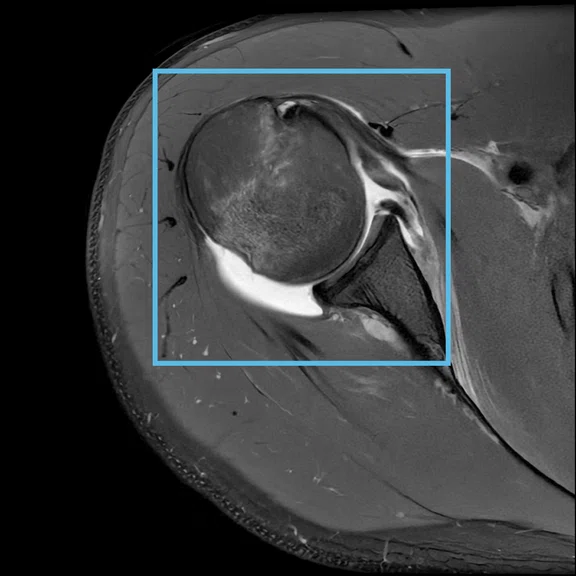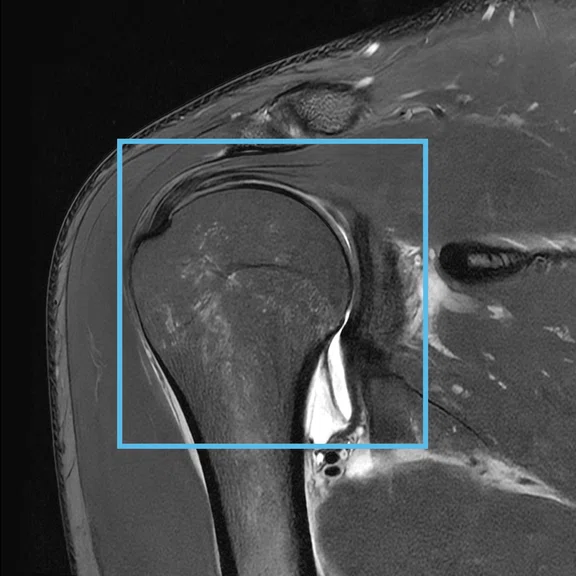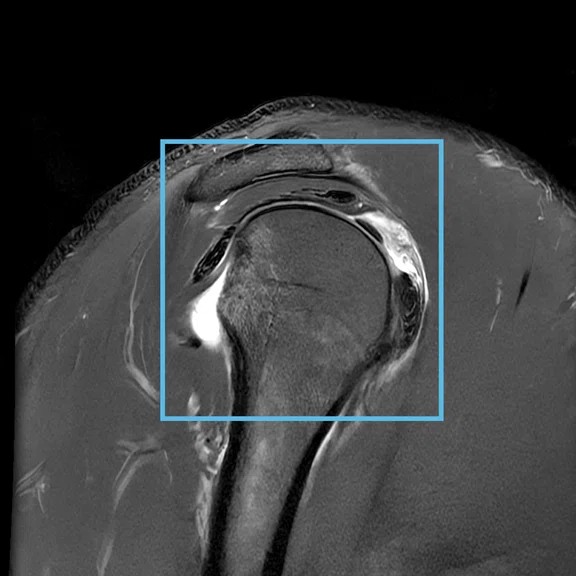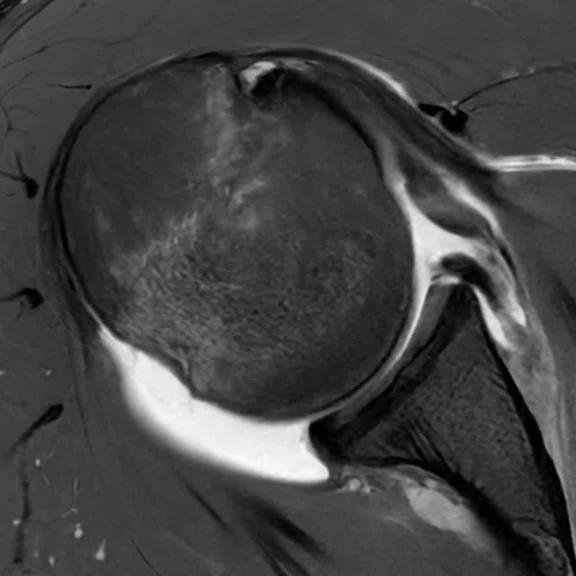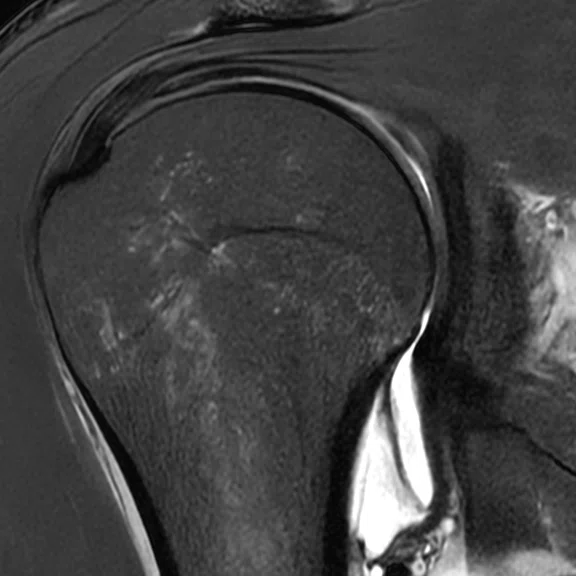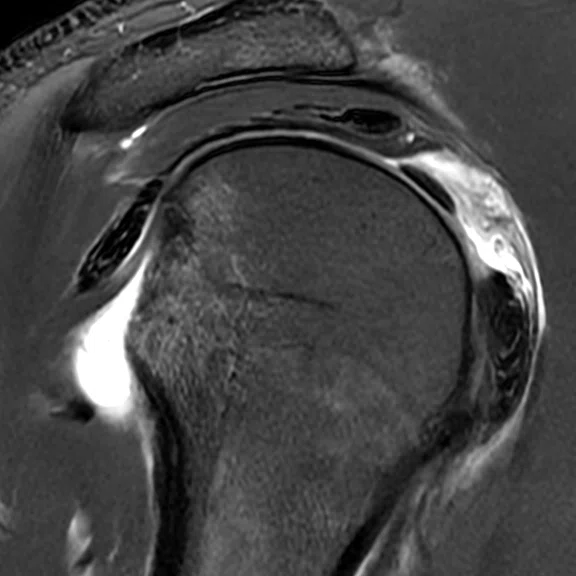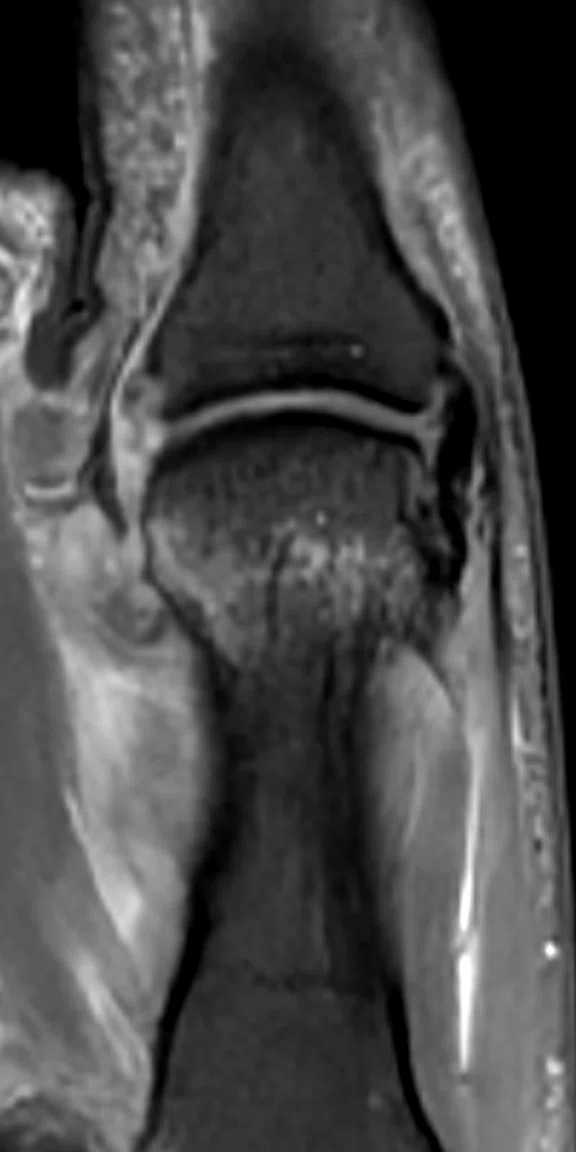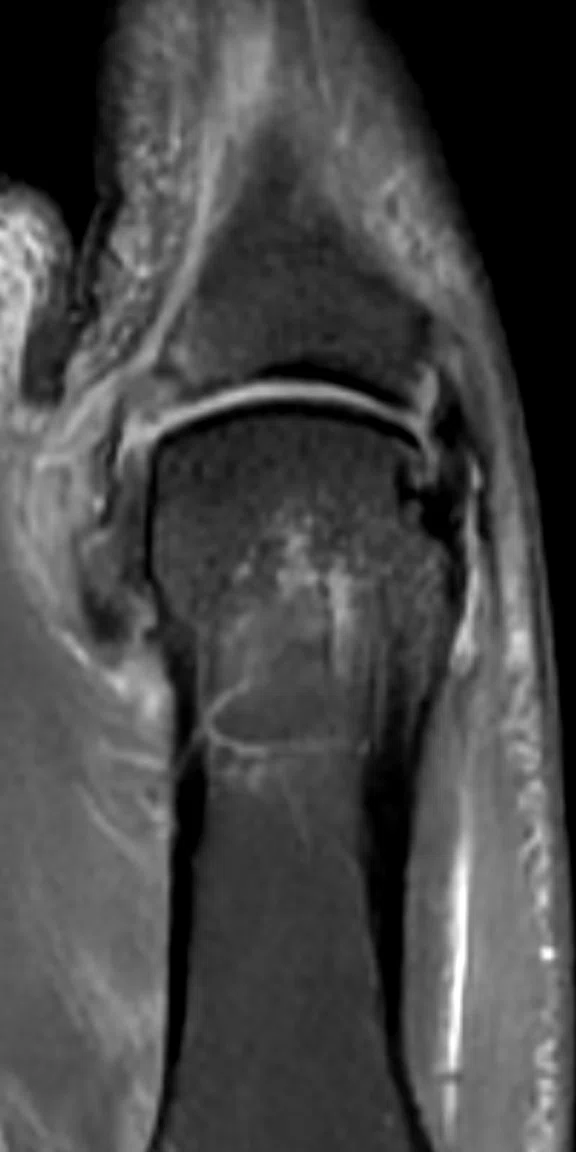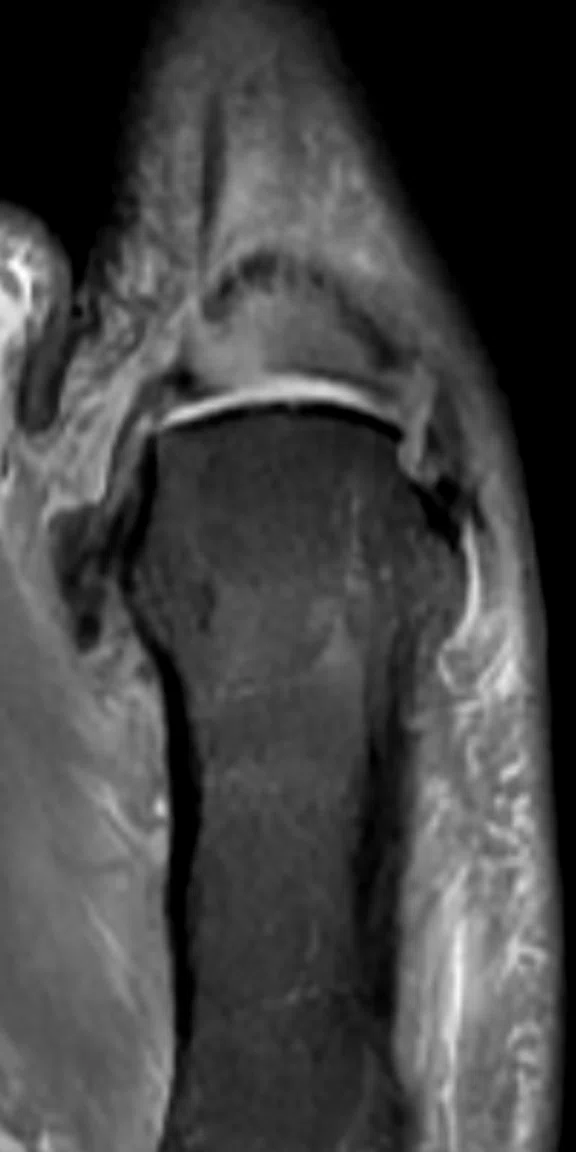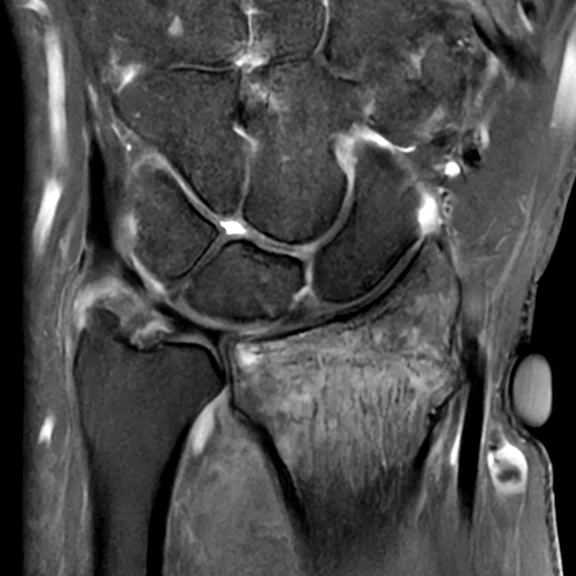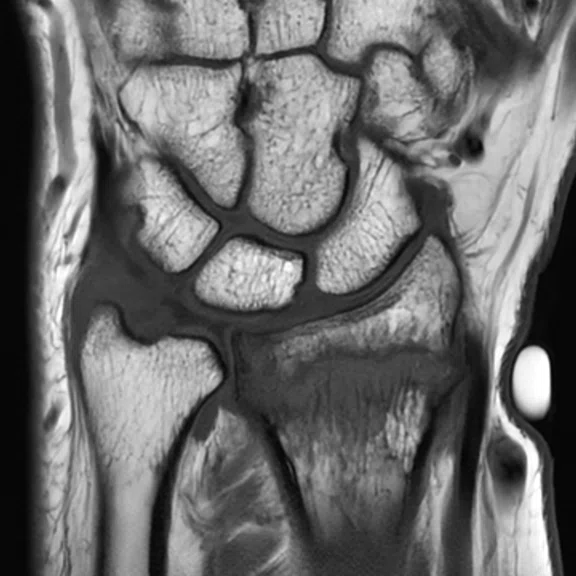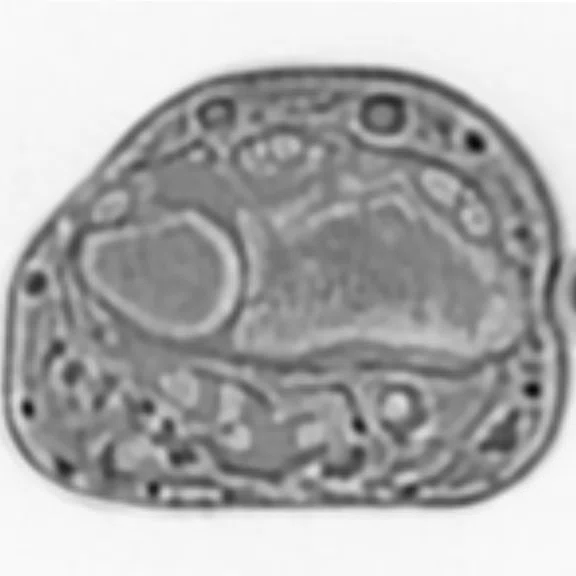1. Peters RD, Harris H, Lawson S. The clinical benefits of AIR™ Recon DL for MR image reconstruction. GE SIGNA Pulse of MR. Autumn 2020, pages 77-80.
2. Boutin RD, Fritz RC. MRI of snow skiing and snowboarding injuries. Seminars in musculoskeletal radiology. 2005;9(4):360-78.
3. Deady LH, Salonen D. Skiing and snowboarding injuries: a review with a focus on mechanism of injury. Radiologic clinics of North America. 2010;48(6):1113-24.
2. Boutin RD, Fritz RC. MRI of snow skiing and snowboarding injuries. Seminars in musculoskeletal radiology. 2005;9(4):360-78.
3. Deady LH, Salonen D. Skiing and snowboarding injuries: a review with a focus on mechanism of injury. Radiologic clinics of North America. 2010;48(6):1113-24.
A-1
Figure 1.
Skiing-related knee injury. Coronal proton density (PD) FatSat and sagittal PD FatSat sequences were acquired on the SIGNA™ Pioneer system and reconstructed with AIR™ Recon DL. Imaging findings include: (A, B) a non-displaced tibial-sided avulsion of the PCL; (A) a partial tear of the MCL with proximal retraction of the meniscofemoral extension of the deep portion and a horizontal tear of the posterior horn of the medial meniscus; (B) a focal cartilage damage of the femoral trochlea; and (C) a longitudinal “zip” tear of the posterior horn of the lateral meniscus.
B-1
Figure 1.
Skiing-related knee injury. Coronal proton density (PD) FatSat and sagittal PD FatSat sequences were acquired on the SIGNA™ Pioneer system and reconstructed with AIR™ Recon DL. Imaging findings include: (A, B) a non-displaced tibial-sided avulsion of the PCL; (A) a partial tear of the MCL with proximal retraction of the meniscofemoral extension of the deep portion and a horizontal tear of the posterior horn of the medial meniscus; (B) a focal cartilage damage of the femoral trochlea; and (C) a longitudinal “zip” tear of the posterior horn of the lateral meniscus.
C-1
Figure 1.
Skiing-related knee injury. Coronal proton density (PD) FatSat and sagittal PD FatSat sequences were acquired on the SIGNA™ Pioneer system and reconstructed with AIR™ Recon DL. Imaging findings include: (A, B) a non-displaced tibial-sided avulsion of the PCL; (A) a partial tear of the MCL with proximal retraction of the meniscofemoral extension of the deep portion and a horizontal tear of the posterior horn of the medial meniscus; (B) a focal cartilage damage of the femoral trochlea; and (C) a longitudinal “zip” tear of the posterior horn of the lateral meniscus.
A-2
Figure 1.
Skiing-related knee injury. Coronal proton density (PD) FatSat and sagittal PD FatSat sequences were acquired on the SIGNA™ Pioneer system and reconstructed with AIR™ Recon DL. Imaging findings include: (A, B) a non-displaced tibial-sided avulsion of the PCL; (A) a partial tear of the MCL with proximal retraction of the meniscofemoral extension of the deep portion and a horizontal tear of the posterior horn of the medial meniscus; (B) a focal cartilage damage of the femoral trochlea; and (C) a longitudinal “zip” tear of the posterior horn of the lateral meniscus.
B-2
Figure 1.
Skiing-related knee injury. Coronal proton density (PD) FatSat and sagittal PD FatSat sequences were acquired on the SIGNA™ Pioneer system and reconstructed with AIR™ Recon DL. Imaging findings include: (A, B) a non-displaced tibial-sided avulsion of the PCL; (A) a partial tear of the MCL with proximal retraction of the meniscofemoral extension of the deep portion and a horizontal tear of the posterior horn of the medial meniscus; (B) a focal cartilage damage of the femoral trochlea; and (C) a longitudinal “zip” tear of the posterior horn of the lateral meniscus.
C-2
Figure 1.
Skiing-related knee injury. Coronal proton density (PD) FatSat and sagittal PD FatSat sequences were acquired on the SIGNA™ Pioneer system and reconstructed with AIR™ Recon DL. Imaging findings include: (A, B) a non-displaced tibial-sided avulsion of the PCL; (A) a partial tear of the MCL with proximal retraction of the meniscofemoral extension of the deep portion and a horizontal tear of the posterior horn of the medial meniscus; (B) a focal cartilage damage of the femoral trochlea; and (C) a longitudinal “zip” tear of the posterior horn of the lateral meniscus.
2. Boutin RD, Fritz RC. MRI of snow skiing and snowboarding injuries. Seminars in musculoskeletal radiology. 2005;9(4):360-78.
3. Deady LH, Salonen D. Skiing and snowboarding injuries: a review with a focus on mechanism of injury. Radiologic clinics of North America. 2010;48(6):1113-24.
A-1
Figure 2.
MR arthrography after traumatic anterior shoulder dislocation from a skiing accident. (A) Axial PD FatSat, (B) coronal T2 FatSat and (C) sagittal T2 FatSat acquired on the SIGNA™ Premier system and reconstructed with AIR™ Recon DL. Imaging findings include: (A) a Perthes lesion, Hill-Sachs defect and partial tear of the MGHL, (B) HAGL lesion and (C) interstitial tear of the infraspinatus tendon just posterior to the Hill-Sachs defect. Also note the sharp delineation of the intact supraspinatus tendon, proximal biceps tendon and glenohumeral cartilage.
B-1
Figure 2.
MR arthrography after traumatic anterior shoulder dislocation from a skiing accident. (A) Axial PD FatSat, (B) coronal T2 FatSat and (C) sagittal T2 FatSat acquired on the SIGNA™ Premier system and reconstructed with AIR™ Recon DL. Imaging findings include: (A) a Perthes lesion, Hill-Sachs defect and partial tear of the MGHL, (B) HAGL lesion and (C) interstitial tear of the infraspinatus tendon just posterior to the Hill-Sachs defect. Also note the sharp delineation of the intact supraspinatus tendon, proximal biceps tendon and glenohumeral cartilage.
C-1
Figure 2.
MR arthrography after traumatic anterior shoulder dislocation from a skiing accident. (A) Axial PD FatSat, (B) coronal T2 FatSat and (C) sagittal T2 FatSat acquired on the SIGNA™ Premier system and reconstructed with AIR™ Recon DL. Imaging findings include: (A) a Perthes lesion, Hill-Sachs defect and partial tear of the MGHL, (B) HAGL lesion and (C) interstitial tear of the infraspinatus tendon just posterior to the Hill-Sachs defect. Also note the sharp delineation of the intact supraspinatus tendon, proximal biceps tendon and glenohumeral cartilage.
A-2
Figure 2.
MR arthrography after traumatic anterior shoulder dislocation from a skiing accident. (A) Axial PD FatSat, (B) coronal T2 FatSat and (C) sagittal T2 FatSat acquired on the SIGNA™ Premier system and reconstructed with AIR™ Recon DL. Imaging findings include: (A) a Perthes lesion, Hill-Sachs defect and partial tear of the MGHL, (B) HAGL lesion and (C) interstitial tear of the infraspinatus tendon just posterior to the Hill-Sachs defect. Also note the sharp delineation of the intact supraspinatus tendon, proximal biceps tendon and glenohumeral cartilage.
B-2
Figure 2.
MR arthrography after traumatic anterior shoulder dislocation from a skiing accident. (A) Axial PD FatSat, (B) coronal T2 FatSat and (C) sagittal T2 FatSat acquired on the SIGNA™ Premier system and reconstructed with AIR™ Recon DL. Imaging findings include: (A) a Perthes lesion, Hill-Sachs defect and partial tear of the MGHL, (B) HAGL lesion and (C) interstitial tear of the infraspinatus tendon just posterior to the Hill-Sachs defect. Also note the sharp delineation of the intact supraspinatus tendon, proximal biceps tendon and glenohumeral cartilage.
C-2
Figure 2.
MR arthrography after traumatic anterior shoulder dislocation from a skiing accident. (A) Axial PD FatSat, (B) coronal T2 FatSat and (C) sagittal T2 FatSat acquired on the SIGNA™ Premier system and reconstructed with AIR™ Recon DL. Imaging findings include: (A) a Perthes lesion, Hill-Sachs defect and partial tear of the MGHL, (B) HAGL lesion and (C) interstitial tear of the infraspinatus tendon just posterior to the Hill-Sachs defect. Also note the sharp delineation of the intact supraspinatus tendon, proximal biceps tendon and glenohumeral cartilage.
2. Boutin RD, Fritz RC. MRI of snow skiing and snowboarding injuries. Seminars in musculoskeletal radiology. 2005;9(4):360-78.
3. Deady LH, Salonen D. Skiing and snowboarding injuries: a review with a focus on mechanism of injury. Radiologic clinics of North America. 2010;48(6):1113-24.
A
Figure 3.
Skier’s thumb with Stener lesion five days after a skiing accident. Coronal PD FatSat images were acquired on the SIGNA™ Premier system and reconstructed with AIR™ Recon DL. The UCL is completely torn and its proximal stump is displaced over the adductor aponeurosis (Stener lesion).
B
Figure 3.
Skier’s thumb with Stener lesion five days after a skiing accident. Coronal PD FatSat images were acquired on the SIGNA™ Premier system and reconstructed with AIR™ Recon DL. The UCL is completely torn and its proximal stump is displaced over the adductor aponeurosis (Stener lesion).
C
Figure 3.
Skier’s thumb with Stener lesion five days after a skiing accident. Coronal PD FatSat images were acquired on the SIGNA™ Premier system and reconstructed with AIR™ Recon DL. The UCL is completely torn and its proximal stump is displaced over the adductor aponeurosis (Stener lesion).
A
Figure 4.
Distal radius fracture from a fall on the outstretched hand during skiing. Coronal PD FatSat and T1 sequences were acquired on the SIGNA™ Premier system and (A, B) reconstructed with AIR™ Recon DL. The markedly reduced scan times compared to conventional MR allows for (C) an additional oZTEo sequence, isotropic voxel 0.8 x 0.8 x 0.8 mm3, for detailed multiplanar fracture assessment. The images reveal a minimally displaced fracture of the distal radius extending into the distal radial ulnar joint, radiocarpal joint and Lister’s tubercle.
B
Figure 4.
Distal radius fracture from a fall on the outstretched hand during skiing. Coronal PD FatSat and T1 sequences were acquired on the SIGNA™ Premier system and (A, B) reconstructed with AIR™ Recon DL. The markedly reduced scan times compared to conventional MR allows for (C) an additional oZTEo sequence, isotropic voxel 0.8 x 0.8 x 0.8 mm3, for detailed multiplanar fracture assessment. The images reveal a minimally displaced fracture of the distal radius extending into the distal radial ulnar joint, radiocarpal joint and Lister’s tubercle.
C
Figure 4.
Distal radius fracture from a fall on the outstretched hand during skiing. Coronal PD FatSat and T1 sequences were acquired on the SIGNA™ Premier system and (A, B) reconstructed with AIR™ Recon DL. The markedly reduced scan times compared to conventional MR allows for (C) an additional oZTEo sequence, isotropic voxel 0.8 x 0.8 x 0.8 mm3, for detailed multiplanar fracture assessment. The images reveal a minimally displaced fracture of the distal radius extending into the distal radial ulnar joint, radiocarpal joint and Lister’s tubercle.
result


PREVIOUS
${prev-page}
NEXT
${next-page}
Subscribe Now
Manage Subscription
FOLLOW US
Contact Us • Cookie Preferences • Privacy Policy • California Privacy PolicyDo Not Sell or Share My Personal Information • Terms & Conditions • Security
© 2024 GE HealthCare. GE is a trademark of General Electric Company. Used under trademark license.
SPOTLIGHT
Winter is coming: software upgrade ensures high-quality MR imaging of ski injuries
Winter is coming: software upgrade ensures high-quality MR imaging of ski injuries
by Lukas Filli, MD, RNR am Glattzentrum, Zurich, Switzerland
The onset of winter confronts radiologists with seasonally increased sports injuries such as skiing-related knee injury, traumatic shoulder dislocation or skier's thumb. The impressive image quality and reduced scan times achieved with SIGNA™ Works AIR™ IQ Edition translate into higher diagnositc confidence and protocol flexibility.
The onset of winter confronts radiologists with seasonally increased sports injuries such as skiing-related knee injury, traumatic shoulder dislocation or skier's thumb. The impressive image quality and reduced scan times achieved with SIGNA™ Works AIR™ IQ Edition translate into higher diagnositc confidence and protocol flexibility.
As part of the SIGNA™Works AIR™ IQ Edition software release, AIR™ Recon DL provides high-resolution images with high SNR at markedly reduced scan times1. This technology optimizes the depiction of even small injuries, such as meniscal, labral and ligament tears. Furthermore, the reduction in scan times increases flexibility for individually tailored MR protocols with an additional oZTEo sequence for detailed fracture assessment.
At RNR, we installed the new software in February 2021, becoming the first site in Switzerland with this technology. As opposed to other Alpine countries, Switzerland kept its ski resorts open during the 2020-21 season under strict COVID-19 distancing rules. Therefore, we have already gained experience in using AIR™ Recon DL for patients with ski injuries.
While skiing may be "the best way in the world to waste time" (Glen Plake, famous extreme skier), it is associated with a risk of around three injuries per 1,000 skier days2,3. The most frequently affected joints are the knee, thumb and shoulder. The following cases acquired on our 3.0T SIGNA™ Premier and SIGNA™ Pioneer systems illustrate the clinical usefulness (and beauty) of contemporary MR imaging of ski injuries.
Knee
One-third of injuries in adult skiers involve the knee joint, and the most common injury is an ACL tear. Depending on the direction of the fall, this can be caused by different mechanisms, including valgus-external rotation (forward fall, associated with MCL tear), flexion-internal rotation (backward fall between the skis) or transient anterior dislocation (landing on the tail of the ski after a jump)2,3. PCL injuries are classically encountered in motor vehicle accidents (dashboard injury), but skiing has increased in recent years as another cause. MR imaging has a high sensitivity and specificity for diagnosing acute ACL and PCL tears. However, it is important to pay specific attention to potentially associated injuries such as meniscal tears, which is facilitated with AIR™ Recon DL (Figure 1).
Figure 1.
Skiing-related knee injury. Coronal proton density (PD) FatSat and sagittal PD FatSat sequences were acquired on the SIGNA™ Pioneer system and reconstructed with AIR™ Recon DL. Imaging findings include: (A, B) a non-displaced tibial-sided avulsion of the PCL; (A) a partial tear of the MCL with proximal retraction of the meniscofemoral extension of the deep portion and a horizontal tear of the posterior horn of the medial meniscus; (B) a focal cartilage damage of the femoral trochlea; and (C) a longitudinal “zip” tear of the posterior horn of the lateral meniscus.
Shoulder
Up to 11% of ski injuries involve the shoulder. Anterior shoulder dislocation accounts for 22% of these cases, most commonly from a fall onto an outstretched hand2,3. Figure 2 illustrates how clearly a Perthes lesion is depicted on modern MR arthrography even without scanning the patient in the abduction-external rotation (ABER) position, which might add little benefit in this particular case given the concurrent HAGL lesion ("floating IGHL"). For osseous Bankart lesions, an additional oZTEo sequence can be acquired for fracture evaluation and preoperative planning.
Figure 2.
MR arthrography after traumatic anterior shoulder dislocation from a skiing accident. (A) Axial PD FatSat, (B) coronal T2 FatSat and (C) sagittal T2 FatSat acquired on the SIGNA™ Premier system and reconstructed with AIR™ Recon DL. Imaging findings include: (A) a Perthes lesion, Hill-Sachs defect and partial tear of the MGHL, (B) HAGL lesion and (C) interstitial tear of the infraspinatus tendon just posterior to the Hill-Sachs defect. Also note the sharp delineation of the intact supraspinatus tendon, proximal biceps tendon and glenohumeral cartilage.
Thumb
Injury of the ulnar collateral ligament of the first MCP joint is commonly referred to as "skier’s thumb" because of its high incidence in skiers. It is the most common upper extremity injury in skiing and accounts for 8-17% of all ski injuries2,3. The UCL gets torn when the skier falls and the thumb is abducted and extended by the strap of the ski pole. The proximal stump of a torn UCL may be displaced superficial to the aponeurosis of the adductor hallucis muscle, which is known as Stener lesion, and prevents the UCL from effectively healing. MR imaging has a high sensitivity and specificity for diagnosing UCL tears. AIR™ Recon DL generates sharp images and improves conspicuity of the Stener lesion (Figure 3). If plain radiographs are not available, an additional oZTEo sequence may be helpful in cases of osseous avulsion of the UCL.
Wrist
A fall on an outstretched hand may cause a distal radius fracture in skiers (and more commonly in snowboarders). If conventional radiographs are not conclusive, additional MR imaging including an oZTEo sequence allows simultaneous evaluation of the bones and ligaments at the wrist (Figure 4).
In conclusion, the impressive image quality and reduced scan times achieved with AIR™ Recon DL translate into higher diagnostic confidence and protocol flexibility, ultimately improving patient care. With the reduced exam time, it is possible to include another useful sequence such as oZTEo.
Figure 4.
Distal radius fracture from a fall on the outstretched hand during skiing. Coronal PD FatSat and T1 sequences were acquired on the SIGNA™ Premier system and (A, B) reconstructed with AIR™ Recon DL. The markedly reduced scan times compared to conventional MR allows for (C) an additional oZTEo sequence, isotropic voxel 0.8 x 0.8 x 0.8 mm3, for detailed multiplanar fracture assessment. The images reveal a minimally displaced fracture of the distal radius extending into the distal radial ulnar joint, radiocarpal joint and Lister’s tubercle.











